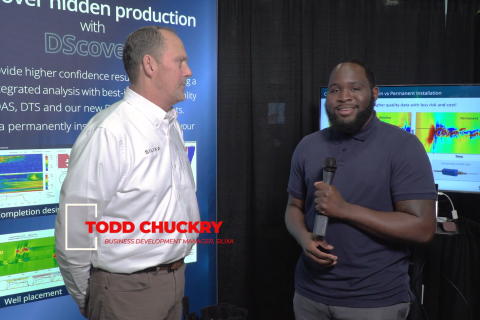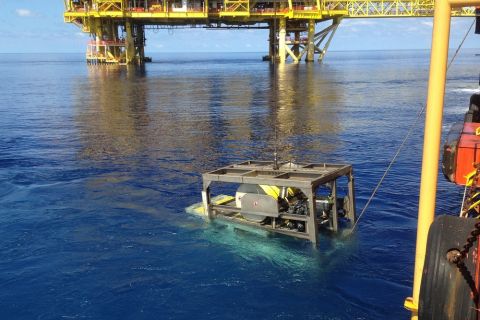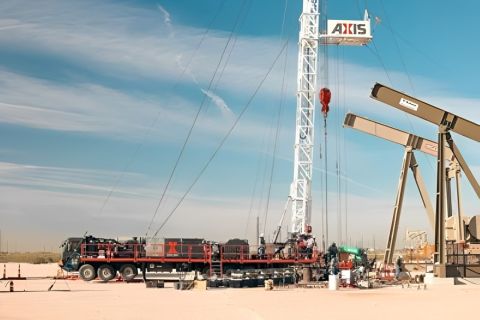 |
| ?Overall, we think there will continue to be significant activity in the Haynesville that will require a lot of capital,” says Jim McBride, Houston-based executive vice president of energy and investment banking at Capital One Southcoast. |
?The Haynesville shale play in northwestern Louisiana continues to be a money-maker as new leases head north of $25,000 per acre. Also, independents already in the play are expanding their developments.
And so they should. Some say the Haynesville/Bossier is the most dynamic play since the Barnett. So far, gas in place, free gas, reservoir pressure and porosities are proving to be favorable by all accounts.
While E&Ps and oilfield-service companies strategize to get in with the biggest bang for their bucks, investments bankers are standing by to provide those bucks. Two of these are Capital One Southcoast and Credit Suisse Securities (USA) LLC.
New-Orleans-based Capital One Southcoast has been in the front yard of the play since before the play was found. New York-based Credit Suisse’s Houston-office bankers have their eyes on the prize as well.
When Capital One acquired Hibernia Bank, which owned Southcoast Capital, it also gained Capital One Southcoast’s energy segment, based in the heart of the Louisiana oil and gas business. The investment-banking boutique formed its energy team some 15 years ago, and its reputation and client base has continued to grow ever since. In fact, in 2006 and 2007, its sales and trading team was named one of the top five “All American Energy Sales Teams” by Institutional Investor.
Jim McBride, Houston-based executive vice president of energy and investment banking at Capital One, recently joined the bank after a long stint at Royal Bank of Scotland. Joining him from RBS were Scott Joyce, senior vice president, and Michael Higgins, vice president.
“My team and I were attracted to Capital One for its growth and entrepreneurial spirit,” says McBride. “The bank already had a proven team of commercial and investment bankers led by David Reid and Patrick Mooney, so it was a phenomenal platform to join and help grow the business.”
Capital One Southcoast has a long track record of financing energy companies, says McBride. “That, combined with the event that one of the largest U.S. gas plays—the Haynesville/Bossier shale play—is developing right in our back yard, is creating significant opportunities for us.”
The bank recently worked with two of its clients, GMX Resources Inc. of Oklahoma City and Houston-based Goodrich Petroleum Corp, to raise capital to accelerate the E&Ps’ development of their shale plays.
GMX raised about $141 million, gross, through one common stock offering. It used the funds to lease and contract to lease an additional 10,955 Haynesville acres, bringing its total Haynesville prospective acreage to 38,455 net acres as of July 31, 2008. GMX has grown its overall net operated position 130% this year, for a total of 41,347 net operated Cotton Valley and Travis Peak acres. At press time, GMX holds a total of 480 net drilling locations in the Haynesville, 80% operated, giving it plenty of running room.
Goodrich issued 3.1 million shares of stock, for a net capital raise of $191.4 million, in part to fund its 2008 capex budget, which it has increased to $350 million, up from a previously announced $275 million.
Goodrich wasted no time strengthening its presence in the Haynesville shale. It recently acquired 3,250 net acres in Caddo Parish, from an undisclosed seller, to gain an estimated 12.3 billion cubic feet of proved reserves associated with the shallower Hosston and Cotton Valley formations. There, the company plans to drill two vertical wells and re-enter another existing well to test the deeper Haynesville formation.
It also holds an estimated 38,500 net acres in the Minden and Beckville fields in Panola and Rusk counties, Texas. The recently added net acreage increases Goodrich’s total net exposure in the Haynesville, excluding its acreage in the Angelina River Trend, to some 60,500 net acres.
Also, Goodrich recently entered into a joint venture with Oklahoma City-based Chesapeake Energy Corp., which will help Goodrich develop its acreage in Caddo and DeSoto parishes in Louisiana.
Another Capital One Southcoast client, Plains Exploration & Production Co. of Houston, also recently entered into a joint venture with Chesapeake with a similar strategy.
“We will be supporting both of them from a credit standpoint,” says McBride. “Plains just expanded its revolving credit facility to support the acquisition of the acreage and also to fund its share of future drilling costs. Capital One committed to the expanded facility. Overall, we think there will continue to be significant activity in the Haynesville that will require a lot of capital,” he says.
He expects more companies will be trading assets and buying into these developments, such as the Plains-Chesapeake and Chesapeake-Goodrich deals. “We’ll help our clients be well positioned to move forward with the development of that.”
Additionally, Capital One Southcoast, along with Wachovia Corp. and JPMorgan Chase, recently financed the acquisition of a $600-million volumetric production payment (VPP) from Chesapeake. Capital One Southcoast is administrative agent. Chesapeake will use the proceeds to fund development of its Haynesville acreage, as well as its significant positions in the Barnett and Fayetteville shales.
The shales also offer opportunities for midstream infrastructure development to support take-away capacities, and subsequent financing that will be required for those deals.
“Although it is a very mature area, there will need to be more take-away capacity to get the gas from the wellhead to the main transmission lines,” says McBride. “We think there will be plenty of new gathering and transportation financing opportunities around the Haynesville and Bossier plays in North Louisiana and East Texas for some time to come.”
Strong interest
Tim Perry, Houston-based managing director and head of E&P for Credit Suisse Securities (USA) LLC for North and South America, also sees plenty of investor interest in the E&P industry from all capital providers—public and private equity, investment and non-investment-grade debt, mezzanine and institutional term loans.
“Credit Suisse has the good fortune to be involved in all those,” says Perry. “And I expect that to continue. I wouldn’t say there will be more interest in debt over equity. I expect to see continuing strong interest from all financial sources.”
The energy industry is managed in a more conservative manner than in the past, he says. “It is really becoming exciting with lots of new opportunities for drilling, such as the unconventional plays in North America. Investors see it as having strong opportunities for excellent returns over the next several years.”
Overall, Perry does note a significant increase in public-equity offerings, relative to a year ago, possibly due to two reasons. First, in conjunction with higher commodity and share prices experienced earlier this year, companies were interested in issuing equity. Second, there has been robust M&A activity. Many companies went to the equity market to fund acquisitions, sometimes repeatedly. However, since July, some stocks are undervalued, so the follow-on flow may become somewhat reduced, he says.
Recent undervaluation of E&P stocks has occurred because current stock prices,?on average, only incorporate slightly more than the value of proved reserves. However, with the inclusion of unproved reserves, an E&P’s upside potential leaps to almost 50%.
Nonetheless, Chesapeake and Petrohawk Energy Corp. recently went to the equity markets again, successfully, says Perry. The market success of these offerings is driven by interest in various unconventional resource plays like the Haynesville, Marcellus and Barnett gas shales and the Bakkan oil shale.
Most of the transactions this year have been asset, rather than corporate, deals, says Perry. E&Ps prefer to pick up acres in one core geographic area, as opposed to acquiring acreage in non-focus areas, which often happens in corporate acquisitions. Also, while IPOs have been somewhat scarcer than in the past, due to the recent trend of undervalued stock prices, they have not completely stopped.
“We were involved in the largest IPO of an E&P this year,” says Perry, referring to Brazil’s OGX Petroleo e Gas Participacoes. It was an initial public offering of some $3.6 billion. OGX was formed in September 2007 and IPO’d at $1,345 per share on June 13. At press time, the stock was trading at about $750. Nonetheless, OGX has grown to be a $10-billion-plus-market-cap E&P very quickly. Credit Suisse was the left-book-runner for the offering.
OGX’s blocks reside in the same geological formation as Petrobras’ Tupi subsalt discovery of an estimated 5- to 8 billion of recoverable oil reserves—the biggest deepwater oil field ever found. Petrobras has since announced other large finds in the subsalt layer, but it has not yet given reserve estimates for these.
“That IPO was the result of investor interest and demand for Brazilian offshore E&P equity,” says Perry. “It was a well-received IPO, and significantly oversubscribed.”
Also, Perry says, the private placement market has been “terrific so far” and should continue to be so going into next year. Placement deals, such as the recent spate of private equity flowing into Calgary-based oil-sands player MEG Energy, should continue into 2009.
Regarding debt markets, Perry has seen investors’ interest growing for the institutional term loan market. “For example, at the end of June, we led a $1.65-billion institutional term loan for ATP Oil & Gas Corp.”
Gulf of Mexico- and North Sea-focused, Houston-based ATP entered a $1.05-billion senior secured term-loan facility, due 2014, to replace its $1.2-billion senior secured loan due 2010, and to pay debt and fund working capital. Credit Suisse was lead arranger. For a single B or lower or non-rated E&P, it was the largest institutional term loan ever executed for a U.S. independent E&P.
Recommended Reading
Exclusive: Silixa’s Distributed Fiber Optics Solutions for E&Ps
2024-03-19 - Todd Chuckry, business development manager for Silixa, highlights the company's DScover and Carina platforms to help oil and gas operators fully understand their fiber optics treatments from start to finish in this Hart Energy Exclusive.
CERAWeek: AI, Energy Industry Meet at Scary but Exciting Crossroads
2024-03-19 - From optimizing assets to enabling interoperability, digital technology works best through collaboration.
Cyber-informed Engineering Can Fortify OT Security
2024-03-12 - Ransomware is still a top threat in cybersecurity even as hacktivist attacks trend up, and the oil and gas sector must address both to maintain operational security.
Forum Energy Signs MOU to Develop Electric ROV Thrusters
2024-03-13 - The electric thrusters for ROV systems will undergo extensive tests by Forum Energy Technologies and SAFEEN Survey & Subsea Services.
Axis Energy Deploys Fully Electric Well Service Rig
2024-03-13 - Axis Energy Services’ EPIC RIG has the ability to run on grid power for reduced emissions and increased fuel flexibility.





